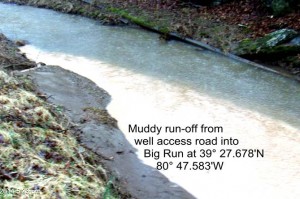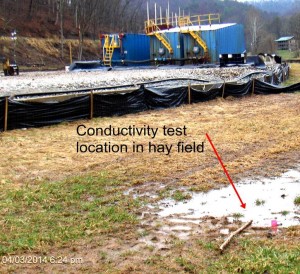Report on Drilling & Fracking on Big Run in Tyler County
By William J. Hughes, WV Route 7, April 5, 2014
In a number of my recent Power Point presentations on the black shale “exploration & production” process I have included a slide which I think represents a challenge to WV-DEP. I could not help but to be reminded of it during my recent visit in the Jay Bee footprint area near Big Run, in Tyler county, including the Lisby pad.
“AIR-WATER-LAND: We must Protect our Air & Water & Land while Looking for Balance in our Quest for Energy.” <Wetzel County Action Group>.
Please take the time to consider the implications. We here in the active Marcellus areas are not creating imaginary problems. These are real problems. Easily seen if anyone wants to look. The photos and situations represent many of the examples of Marcellus done wrong. Here along Big Run, within one mile, within one hour, for just one operator, my neighbors’ AIR—WATER—LAND were all being contaminated to get cheap gas in an irresponsible manner on a continuing basis. No corner is left uncut.
AIR
As many interested parties in most surrounding states know by now, the West Virginia Jay-Bee Oil & Gas Lisby pad has been a major air pollution problem for over a week. The neighbors had to leave their homes to stay elsewhere because of the toxic fumes in the valley caused by the massive venting of raw gas and condensate fumes. The families could not moved back and have not moved back. [The noxious gases are still being emitted, the odors remain in the valley, and residents are fearful their headaches and burning nostrils may have long term effects, as of April 9th.]
While trying to stay upwind, I could again smell the gas fumes both on the road and in the hay field between the well pad and the stream bed. The fumes are somewhat visible, but thru the binoculars all vent pipes clearly showed a steady stream of gases still being released into the sinking air.
WATER
Jay-Bee Oil & Gas has at least three well pads in that area of Big Run. An access road goes up the hill to the RPT 5 and RPT 8 well pads. Due to improper or nonexistent Erosion and Sedimentation controls and the apparent absence of implementing “best management practices” (BMPs) for sediment control, a large muddy stream was flowing off the well access road area. The stream water was much cleaner upstream.
For comparison of near simultaneous surface water runoff quality, about a mile to the west, about only 35 minutes later, where it was also still raining, . One could literally drink from this stream. Conductivity measured 99 mS. Same amount of rain, running clear and clean. No J & B well activity above it. It seems obvious that improvements in enforcement of erosion and sedimentation control practices are needed.
LAND
At the Lisby pad, the conductivity in the hay field between the silt fence and Big Run was checked. The conductivity measure approximately 5,000 mS, which would normally be under 100. This level of contamination is comparable to what has been previously documented. This is the location of severe contamination from the January 2, 2014, explosion and discharge of all the tanks contents onto an unlined dirt area around the tanks and into the hay field. The “clean up” was clearly inadequate, ineffective and incomplete.
We have regularly measured high readings. Black goo was washed into the stream on Jan. 5. 2014 during the early morning rainstorm. More water contamination for Big Run.
Conductivity in the hay field. 5,048 mS. Measured on April 3, 2014.
Interesting observation: Three of the 6 tanks on the Lisby pad just a few days before the explosion, shows there are no vent pipes on the tanks. The white vent pipes, on the tanks now, were added after the explosion. One would expect an automatic overflow, self-draining feature.



{ 1 comment… read it below or add one }
Please email me a contact number.
What was EPA’s response?
Please google “those hills are home”
with Jon and Annie Seay, Lima WV.